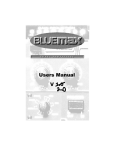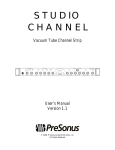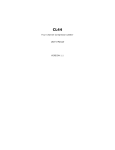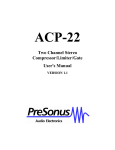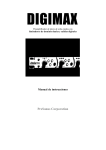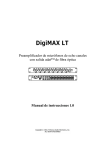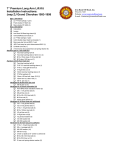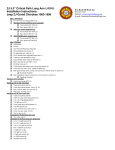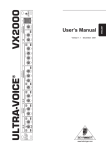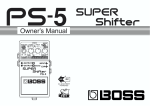Download Presonus Audio electronic Smart Compressor Stereo Equalizer User Manual
Transcript
SMART COMPRESSOR USERS MANUAL Version 1.0 1997, PreSonus Audio Electronics, Incorporated. All rights reserved. WARRANTY PreSonus Limited Warranty PreSonus Audio Electronics Inc. warrants this product to be free of defects in material and workmanship for a period of one year from the date of original retail purchase. This warranty is enforceable only by the original retail purchaser. To be protected by this warranty, the purchaser must complete and return the enclosed warranty card within 14 days of purchase. During the warranty period PreSonus shall, at its sole and absolute option, either repair or replace, free of charge, any product that proves to be defective on inspection by PreSonus or its authorized service representative. To obtain warranty service, the purchaser must first call or write PreSonus at the address and telephone number printed below to obtain a Return Authorization Number and instructions of where to return the unit for service. All inquiries must be accompanied by a description of the problem. All authorized returns must be sent to the PreSonus repair facility postage prepaid, insured and properly packaged. PreSonus reserves the right to update any unit returned for repair. PreSonus reserves the right to change or improve the design of the product at any time without prior notice. This warranty does not cover claims for damage due to abuse, neglect, alteration or attempted repair by unauthorized personnel, and is limited to failures arising during normal use that are due to defects in material or workmanship in the product. Any implied warranties, including implied warranties of merchantability and fitness for a particular purpose, are limited in duration to the length of this limited warranty. Some states do not allow limitations on how long an implied warranty lasts, so the above limitation may not apply to you. In no event will PreSonus be liable for incidental, consequential or other damages resulting from the breach of any express or implied warranty, including , among other things, damage to property, damage based on inconvenience or on loss of use of the product, and, to the extent permitted by law, damages for personal injury. Some states do not allow the exclusion of limitation of incidental or consequential damages, so the above limitation or exclusion may not apply to you. This warranty gives you specific legal rights, and you may also have other rights which vary form state to state. This warranty only applies to products sold and used in the United States of America. For warranty information in all other countries please refer to your local distributor. PreSonus Audio Electronics, Inc. 501 Government St. Baton Rouge, LA 70802 (504) 344-7887 1997, PreSonus Audio Electronics, Incorporated. All rights reserved. TABLE OF CONTENTS 1 Overview A Word About Compression 4 1.1 Introduction 6 1.2 Features 6 2 Controls & Connections 2.1 Front Panel Basic Layout 8 2.2 Back Panel Basic Layout 12 2.3 Presets 14 3 Basic Setup & Operation 3.1 Quick Start 18 3.2 Basic Connections 19 3.3 Basic Operating Procedures 21 4 4.1 Technical Specifications 24 3 1 OVERVIEW A Word About Compression . . . . Punch, apparent loudness, presence just three of many terms used to describe the effects of compression/ limiting. Compression and limiting are forms of dynamic range (volume) control. Audio signals have very wide peak to average signal level ratios (sometimes referred to as dynamic range which is the difference between the loudest level and the softest level). The peak signal can cause overload in the audio recording or reproduction chain resulting in signal distortion. A compressor/limiter is a type of amplifier in which gain is dependent on the signal level passing through it. You can set the maximum level a compressor/limiter allows to pass through, thereby causing automatic reduction above some predetermined signal level or Compression gain threshold. refers basically to the ability to reduce the output level of an audio signal by a fixed ratio relative to the input. It is useful for lowering the dynamic range of an instrument or vocal, making it easier to record without distorting the recorder. It also assists in the mixing process by reducing the amount of level changes needed for a particular instrument. Take, for example, a vocalist who moves around in front of the microphone while performing, thus making the output level vary up and down unnaturally. A compressor can be applied to the signal to help correct this recording problem by reducing the louder passages enough to be compatible with the overall performance. How severely the compressor reduces the signal is determined by the compression ratio and compression threshold. A ratio of 2:1 or less is considered mild compression, reducing the output by two for signals greater than the compression threshold. Ratios above 10:1 are considered hard limiting. Limiting refers to the point at which the signal is restrained from going any louder at the output. The level of input signal at which the output is reduced is determined by the compression threshold. As the compression threshold is lowered, more and more of the input signal is compressed (assuming a nominal input signal level). Care must be taken not to over compress a signal. 4 Too OVERVIEW much compression destroys the acoustical dynamic response of a performance. (Over compression, however, is used by some engineers as an effect, and with killer results!) Compressor/limiters are commonly used for many audio applications. A kick drum can get lost in a wall of electric guitars. No matter how much level is increased, the kick drum stays lost in the mud. Add a touch of compression and tighten up that kick drum sound allowing it to punch through without having to crank the level way up. A vocal performance usually has a wide dynamic range. Transients (the very loudest portion of the signal) can be far outside the average level of the vocal signal. It is extremely difficult to ride the level with a console fader. A compressor/limiter automatically controls gain without altering the subtleties of the performance. A solo guitar can seem to be masked by the rhythm guitars. Compression can make your lead soar above the track without shoving the fader through the roof . Bass guitar can be difficult to record . A consistent level with good attack can be achieved with proper compression . Your bass doesnt have to be washed out in the low end of the mix . Let the compressor/limiter give your bass the punch it needs to drive the bottom of the track . 5 OVERVIEW 1 . 1 Thank I N T R O D U C T I O N you for purchasing the PreSonus Blue Max smart compressor/limiter with presets. Your Blue Max was designed with you, the end user in mind. As far as we know, it is the only compressor in the world with built-in compression presets. The presets were created not only to assist in setting up the compressor but to offer you the experience of professional engineers in using compression. If this is your first compressor, you will instantly gain valuable insight into what can be a confusing experience. The experienced user will gain a few tricks of the trade usually kept in the arsenal of professional engineers. This dynamics processor was built with state of the art components to deliver crystal clear compression for an infinite period of time. We believe the Blue Max to be an exceptional sounding unit at an exceptional price. We hope you agree. Feel free to contact us at 1-800-750-0323 anytime for any reason. We value your comments and suggestions. Please pay close attention to how you connect your Blue Max to your system. Improper grounding is the most common cause of noise problems in both live and studio applications. We suggest you look at the connection diagrams which are part of this manual to insure optimum operation. Good luck and enjoy your Blue Max! 1 . 2 F E A T U R E S The following is a summary of the features of the Blue Max: 6 OVERVIEW • PRESETS. There are 15 studio proven settings for voice, percussion, fretted instruments, keyboards, stereo processing and effects. • VARIABLE INPUT CONTROL. In addition to normal stereo inputs the input control allows low signal levels such as direct output of electric guitars and basses to be increased to optimum levels. • MANUAL MODE. Full operator control of ratio, attack and release is offered in manual mode. • STEREO INPUTS/OUTPUTS. ¼ inch unbalanced stereo inputs (left side mono) and ¼ inch unbalanced stereo outputs (left side mono) for stereo recording and mix down use. • FULL METERING. Full metering for input and output levels are available as well as separate meters for gain reduction. • VARIABLE OUTPUT. Output control allows gain changes from -20dB to +20dB. • SIDECHAIN INSERT. Sidechain insert allows the Blue Max to be used for special processing applications such as de-essing and ducking. • +4dBu OR -10dBV OPERATION. Internal operating levels are switchable from +4dBu to -10dbV for system matching requirements. • INTERNAL POWER SUPPLY. 7 No Wall Wart! 2 CONTROLS & CONNECTIONS 2 . 1 F R O N T P A N E L B A S I C L A Y O U T The front panel on the Blue Max is divided into three sections. These are: 1. Presets: Fifteen detented preset positions and Manual select. The Presets for the Blue Max are controlled by this sixteen position rotary encoder. As the encoder is rotated, parameters are digitally switched, simultaneously controlling attack, release, ratio and threshold. 2. Controls: & Meters Input 8 CONTROLS & CONNECTIONS The Input control adjusts the gain on the input amplifiers for both channels. Amplification gain varies widely from -20dB to +40dB. The large range is necessary to amplify instruments such as guitar. Thus the input stage to the Blue Max is actually a pre-amp. Note: The input control is always active, even in manual mode. Ratio Ratio sets the compression slope. This is defined as the output level versus the input level. For example, if you have the ratio set to 2:1, any signal levels above the threshold (note: threshold is a preset parameter in the Blue Max) will be compressed at a compression ration of 2:1. This simply means that for every 1dB of level increase into the compressor, the output will only increase 1/2dB, thus producing a compression gain reduction of 0.5dB. As you increase the ratio, the compressor gradually becomes a limiter. A limiter is defined as a processor that limits the level of a signal to the compression threshold. For example, if you have the ratio set to 20:1, input set at 0dB, the output of the Blue Max will be limited to the internal threshold of the compressor, which is set to 10dB in manual mode. Note: The ratio control is only active in manual mode. 9 CONTROLS & CONNECTIONS Attack and Release Attack sets the speed at which the compressor acts on the input signal. A slow attack time (fully clockwise) allows the beginning envelope of a signal (commonly referred to as the initial transient) to pass through the compressor uncompressed, whereas a fast attack time (fully counter-clockwise) immediately subjects the signal to the ratio and threshold settings of the compressor. Release sets the length of time the compressor takes to return the gain reduction back to zero (no gain reduction). Very short release times can produce a very choppy or jittery sound, especially in low frequency instruments such as a bass guitar. Very long release times can result in an over compressed sound, sometimes referred to as squashing the sound. All ranges of release can be useful at different times however and you should experiment to become familiar with the different sound possibilities. Note: The Attack and Release controls are only active in Manual mode. Input / Output Meter The Input/Output meter shows the signal level being processed by the Blue Max. Input refers to the signal level being processed by the Blue Max before processing. Output refers to the signal level 10 CONTROLS & CONNECTIONS after processing. 0dB on the meter is referenced to the +4/-10 switch on the rear of the unit. In +4 mode, 0dB = +4dBu. In -10 mode, 0dB = -10dBV. Gain Reduction Meter The Gain Reduction meter indicates the amount of gain being reduced by the compressor in dB. 3. Output & Pushbuttons Output Level Control The Output control is used to set the desired output of the Blue Max. It is sometimes referred to as gain makeup control. This terms is derived from the fact that as the compressor lowers the output level during gain reduction, the overall signal level is lowered, requiring the user to makeup the gain thereby restoring the original signal level. Input / Output Meter Select This button selects the function of the Input/Output meter. Pushed in, the meter gives you the level of the input signal. Pushed out, the meter gives you the level of the signal after compression; the output level. 11 CONTROLS & CONNECTIONS Process In/Out The Process button is similar to a bypass button except that the signal is still effected by the Input of the Blue Max. Pushed in, the Blue Max is processing the signal (compressing). Pushed out, the Blue Max is no longer compressing the signal, however the input gain setting remains active. 2 . 2 B A C K P A N E L L A Y O U T Input The input jack accepts unbalanced tip-sleeve connectors. The input can handle up to +24dBu unbalanced levels. The left input is a dedicated mono input. Output The output jack accepts unbalanced tip-sleeve connectors. The output will deliver up to +24dBu in signal level unbalanced. The left output is a dedicated mono output. Sidechain The sidechain jack on each channel interrupts the signal that the compressor is using to determine the amount of gain reduction to apply. When no connector is inserted into this jack, the input signal goes directly to the compressors control circuitry. When a connector is inserted into this jack, the signal path is broken. If you have inserted a tip-ring-sleeve connector, the input signal is sent back out of the Blue Max via the tip of the connector. This 12 CONTROLS & CONNECTIONS signal can then be processed by an equalizer for example to reduce sibilance (de-essing) in a vocal track. The signal is then returned to the unit via the sleeve of the connector. The signal sent to the sleeve could be that of a narrator or vocalist. In this application, the audio that you are passing through the compressor will automatically duck when the narrator speaks or vocalist sings. +4/-10 Switch This switch adjusts the internal operating level of your Blue Max when it is connected to line level (0dB = -10dBV) gear. With the switch in the -10 position, the signal is raised internally so that it is processed at the lower noise floor of your Blue Maxs internal circuitry. The signal level is lowered on the way out to match up with your line level gears input. When the switch is in the +4 position, the signal is not changed since this matches the internal operating level of your Blue Max. This function may also be useful in creating special effects with the compressor and gate of the channel by overcompressing. 2 . 3 P R E S E T S Vocal 1 SOFT - Easy compression. A low ratio setting for ballads allowing a wider dynamic range. Good for live use. This setting lets the vocal sit in the track. 2 Threshold Ratio Attack Release -8.2dB 1.8:1 0.002mS 38mS MEDIUM - More limiting than preset 1 for a narrower dynamic range. 13 CONTROLS & CONNECTIONS It moves the vocal more up front in the mix. 3 Threshold Ratio Attack Release -3.3dB 2.8:1 0.002mS 38mS SCREAMER - For loud vocals. Fairly hard compression for a vocalist who is on and off the microphone a lot. It puts the voice in your face. Threshold Ratio Attack Release -1.1dB 3.8:1 0.002mS 38mS Perc. 1 SNARE/KICK - Allows the first transient through and compresses the rest of the signal giving a hard snap up front with a longer release. 2 Threshold Ratio Attack Release -2.1dB 3.5:1 78mS 300mS L/R (Stereo) OVERHEAD - A low ratio and threshold gives a fat contour to even out the sound from overhead drum mics. Low end is increased and the overall sound is more present and less ambient. More boom less room. Threshold Ratio Attack Release -13.7dB 1.3:1 27mS 128mS Fretted 1 ELECTRIC BASS - A fast attack and slow release to tighten up the 14 CONTROLS & CONNECTIONS electric bass and give you control for more consistent level. 2 Threshold Ratio Attack Release -4.4dB 2.6:1 45.7mS 189mS ACOUSTIC GUITAR - This setting accentuates the attack of the acoustic guitar and helps maintain an even signal level keeping the acoustic guitar from disappearing in the track. 3 Threshold Ratio Attack Release -6.3dB 3.4:1 188mS 400mS ELECTRIC GUITAR - A setting for crunch electric rhythm guitar. A slow attack helps get the electric rhythm guitar up close and personal and gives punch to your crunch. Threshold Ratio Attack Release 0.1dB 2.4:1 26mS 194mS Keyboards 1 PIANO - A special setting for an even level. Designed to help even up the top and bottom of an acoustic piano. Helps the left hand be heard with the right hand. 2 Threshold Ratio Attack Release -10.8dB 1.9:1 108mS 112mS SYNTH - Fast attack and release for synthesizer horn stabs and for bass lines played on a synthesizer. Threshold Ratio Attack Release -11.9dB 1.8:1 0.002mS 85mS 15 CONTROLS & CONNECTIONS 3 ORCHESTRAL - Use this setting for string pads and other types of synthesized orchestra parts. It will decrease the overall dynamic range for easier placement in the mix. Threshold Ratio Attack Release 3.3dB 2.5:1 1.8mS 50mS Stereo 1 STEREO LIMITER - Just as the name implies. A hard limiter setting (brick wall) ideal for controlling level to the 2 track mixdown deck or stereo output. 2 Threshold Ratio Attack Release 5.5dB 7.1:1 0.001mS 98mS CONTOUR - A contoured setting for use on the stereo output to fatten up the mix. Threshold Ratio Attack Release -13.4dB 1.2:1 0.002mS 182mS Effects 1 SQUEEZE - Dynamic compression for solo work, especially electric guitar. It gives you that glassy tele/strat sound. A true classic. Threshold Ratio Attack Release -4.6dB 2.4:1 7.2mS 93mS 16 CONTROLS & CONNECTIONS 2 PUMP - Make the Blue Max pump up the prime. A setting for making the compressor pump in a desirable way. This effect is good for snare drum to increase the length of the transient by bringing the signal up after the initial spike. Very contemporary. Threshold Ratio Attack Release 0dB 1.9:1 1mS 0.001mS 17 3 BASIC SETUP & OPERATION 3 . 1 Q U I C K S T A R T 1. Connect your Blue Max using one of the diagrams below. 2. Select either +4 or -10 operating level. (Reminder: +4 is for pro levels such as consoles, -10 is for consumer levels or instruments) 3. Select your preset. (Refer to the preset descriptions above. Remember that the Ratio, Attack and Release knobs are only active in Manual mode.) 4. Push the Process button 5. Turn the Input knob all the way to -20 (counter-clockwise). 6. Set the Output knob on 0. 7. Slowly turn the Input knob up (clockwise) until the Gain in. Reduction meters begin to move. Continue to rotate the Input knob until the Gain Reduction meters read between -5 and -7. 8. Adjust the Output knob to the desired output level. You should now have a very natural sounding compressed signal. Of course you should experiment with the settings to suit your taste. 18 BASIC SETUP & OPERATION 3 . 2 B A S I C C O N N E C T I O N S Inserting into your mixers insert point. Note: If you dont get any signal flow at first, try swapping the input and output connections. 19 BASIC SETUP & OPERATION Connecting your instrument, mixer or tape machine. Connecting for de-essing or spectral processing. 20 BASIC SETUP & OPERATION Connecting for stereo operation. 3 . 3 B A S I C O P E R A T I N G P R O C E D U R E S Setting Compression Amount Your Blue Max was designed with a fixed threshold mode of operation. This differs from other compressors in the fact that there is no threshold control. This offers the unique ability to immediately hear the sometimes subtle differences between presets which each have unique threshold settings. In setting the compression amount, always begin with the Input control all the way counter-clockwise (-20dB), and slowly increase the input until the Gain Reduction meters begin to register the compression activity. The more you crank up the Input the more compression your signal will experience. Always pay close attention to the best judge of your sound, your ear. You should also frequently remove the compression 21 BASIC SETUP & OPERATION from the signal using the Process button to listen to the changes in your sound. In modern recording practice, it is customary to adjust the Output control such that the Input and Output level are of equal amounts according to the Input/Output meter. This gives you an equal level output so that you can switch processing in and out to compare difference. Mono Operation Your Blue Max was designed with a high gain mono input to act as a preamp for instruments such as guitar and bass. Of course, you can also connect your keyboards, etc. in this mode. Note: It is very important not to rely on the high input gain of the Blue Max to boost the level of a signal too low to record or amplify, other than that of instruments such as guitar and bass. Be sure that you are sending the Blue Max at least a moderate level before setting the compression. In this manner you avoid unnecessary input amplifier noise. Stereo Operation Your Blue Max is operating in a linked stereo mode at all times. In this mode, both signals are used to create the gain reduction amount. This insures proper stereo imaging in stereo compression applications. stereo presets were optimized for two basic settings, however all The of the presets will work in stereo mode. Manual Mode With the Preset selector set in the Manual position, you have complete control over the compression settings. In this mode, the threshold is fixed to -10dB. Therefore, your should follow the same setup procedure as in the preset operating modes. Remember that if the Ratio control is set to 1:1 (fully counter-clockwise), the compressor is basically off. A good place to start is with a 2:1 compression setting and Attack and Release in 22 BASIC SETUP & OPERATION the 12oclock positions. You may also want to start with one of the preset settings as described above. 23 4 TECHNICAL 4 . 1 S P E C I F I C A T I O N S Number of Channels.............................................................. 2 Dynamic Range ...........................................................>115dB Signal to Noise Ratio.....................................................>95dB Headroom ....................................................................+24dBu Frequency Response........................................10Hz to 50kHz Crosstalk........................................................>82db @ 10kHz Compression Ratio.................................................. 1:1 to 20:1 Compressor Attack Time.............................0.01mS to 100mS Compressor Release Time ..............................10mS to 500mS Input Impedance, Left/Mono..................................100kOhms Input Impedance, Right ............................................10kOhms Output Impedance.......................................................51Ohms THD + Noise ...............................................................<0.03% Input Gain.......................................................-20dB to +40dB Output Gain ....................................................-20dB to +20dB Compressor Metering ......Input/Output Level,Gain Reduction Sidechain Output Impedance......................................51Ohms Sidechain Input Impedance ......................................10kOhms Internal Operating Level.....................................+4dBu = 0dB Input Range .............................+4dBu or -10dBV, Switchable Input Connectors ............................................1/4, Tip Sleeve Output Connectors..........................................1/4, Tip Sleeve Sidechain Connector..............................1/4, Tip Ring Sleeve Power Supply...................................... Internal, Linear Supply Power Requirements......................120VAC or 240VAC,10W Weight ..............................................................................8lbs. Size .................................................................... 8X1.72X5 24

























